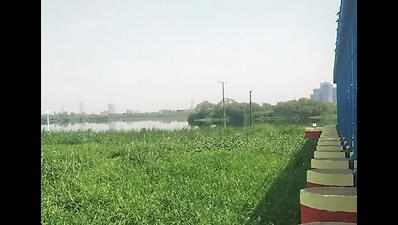- News
- City News
- delhi News
- Hyacinth beds raise dengue-malaria spectre in Delhi
Trending
This story is from April 12, 2021
Hyacinth beds raise dengue-malaria spectre in Delhi
The city is currently braving the double whammy of a surge in Covid-19 cases along with a 6-7 times higher density of mosquitoes. The problem is especially worrisome in areas along the Yamuna due to a dense water hyacinth bed along Kalindi Kunj and Okhla stretching for 2-3 km has become a mosquito-breeding hotspot. The hyacinth has not been cleared for the past two years.

A dense hyacinth bed along Kalindi Kunj and Okhla stretching for 2-3km has become a mosquito-breeding hotspot
NEW DELHI: The city is currently braving the double whammy of a surge in Covid-19 cases along with a 6-7 times higher density of mosquitoes. This has created anxiety among residents regarding the spread of vector-borne diseases.
The problem is especially worrisome in areas along the Yamuna as water hyacinth has not been removed for the past two years.A senior official from South Delhi Municipal Corporation (SDMC) said a dense water hyacinth bed along Kalindi Kunj and Okhla stretching for 2-3 kilometres has become a mosquito-breeding hotspot. Despite the matter being raised repeatedly with other departments, no action has been taken yet.
An intersectoral meeting with officials of Delhi Development Authority, irrigation department, Delhi Jal Board and other agencies was called last week to discuss the issue of unusually high mosquito density and their underlying reasons. “During the meeting, the SDMC commissioner discussed the serious concern with the irrigation department since hyacinth in the Yamuna near Okhla Barrage is severely affecting the colonies along this belt,” said the official.
The areas being severely impacted include Kalindi Kunj, Sarita Vihar, Jasola Vihar, Madanpur Khadar, Jamia Millia Islamia and Abul Fazal Enclave. A senior public health official said, “Flooding of basements, close proximity to the Yamuna and storage of water in jerrycans due to a poor supply network makes some of these areas potential hotspots for dengue and malaria.”
Another official said the dense bed of water hyacinth prohibits larvicide sprays from reaching below the surface. During monsoon, the leaves of these floating plants accumulated water, which leads to breeding of dengue-causing aedes mosquitoes.
A survey conducted by SDMC to assess mosquito density in south Delhi detected levels over six times higher than normal around this time of the year. The west zone reported the highest density at 7.2 units (man per hour), followed by central zone (6.6 units) and south zone (5.8 units), while Najafgarh reported the least at 4.8 units. However, an official said only culex mosquitoes were detected and not the dengue-malaria causing anopheles and aedes genus.
The problem is especially worrisome in areas along the Yamuna as water hyacinth has not been removed for the past two years.A senior official from South Delhi Municipal Corporation (SDMC) said a dense water hyacinth bed along Kalindi Kunj and Okhla stretching for 2-3 kilometres has become a mosquito-breeding hotspot. Despite the matter being raised repeatedly with other departments, no action has been taken yet.
An intersectoral meeting with officials of Delhi Development Authority, irrigation department, Delhi Jal Board and other agencies was called last week to discuss the issue of unusually high mosquito density and their underlying reasons. “During the meeting, the SDMC commissioner discussed the serious concern with the irrigation department since hyacinth in the Yamuna near Okhla Barrage is severely affecting the colonies along this belt,” said the official.
The areas being severely impacted include Kalindi Kunj, Sarita Vihar, Jasola Vihar, Madanpur Khadar, Jamia Millia Islamia and Abul Fazal Enclave. A senior public health official said, “Flooding of basements, close proximity to the Yamuna and storage of water in jerrycans due to a poor supply network makes some of these areas potential hotspots for dengue and malaria.”
Last year, the first malaria death in the city after a gap of more than five years was reported from one of these areas. “The barrage is under the UP irrigation department, which should clean the pondage area regularly. However, they haven’t been able to procure the machines to weed out water hyacinth in the last two years,” added the official.
Another official said the dense bed of water hyacinth prohibits larvicide sprays from reaching below the surface. During monsoon, the leaves of these floating plants accumulated water, which leads to breeding of dengue-causing aedes mosquitoes.
A survey conducted by SDMC to assess mosquito density in south Delhi detected levels over six times higher than normal around this time of the year. The west zone reported the highest density at 7.2 units (man per hour), followed by central zone (6.6 units) and south zone (5.8 units), while Najafgarh reported the least at 4.8 units. However, an official said only culex mosquitoes were detected and not the dengue-malaria causing anopheles and aedes genus.
End of Article
FOLLOW US ON SOCIAL MEDIA










